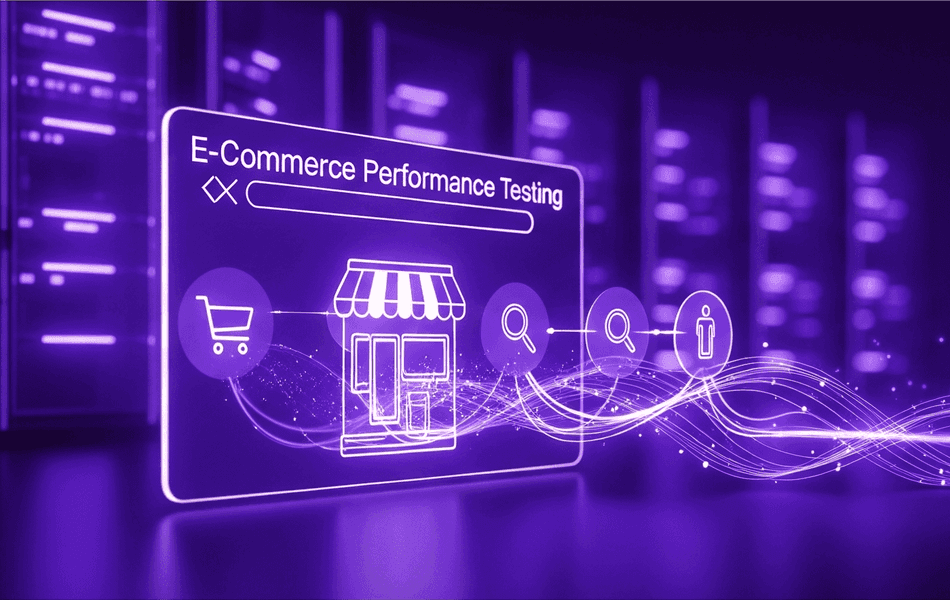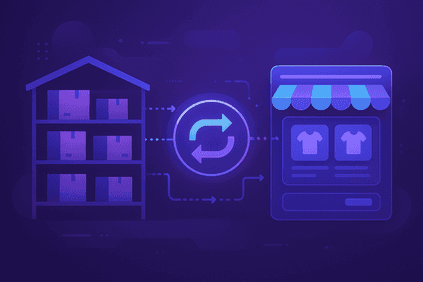E-commerce Load & Stress Testing with k6 on AWS Fargate

Why E-commerce Load Testing is Critical?
E-commerce platforms face unique performance challenges that can make or break business success. This is exactly why e-commerce load testing is critical, it ensures your store can deliver a fast, reliable experience no matter how many users are browsing or buying at once. Unlike traditional websites, online stores must seamlessly handle complex user journeys including:
- Product searches and filtering
- Real-time inventory checks
- Shopping cart management
- Payment processing
- Order fulfillment workflows
The stakes are incredibly high: a single second of delay results in a 7% reduction in conversions, and during peak traffic events like Black Friday or flash sales, even minor performance issues.
The Scale Challenge in E-Commerce Load Testing
In e-commerce, the question isn’t simply whether your platform works - it’s whether it can perform flawlessly when hundreds or thousands of shoppers are online at the same time. E-commerce load testing ensures your site remains fast, stable, and responsive under real-world pressure. Your testing strategy should match your business stage:
- Startups: Validate platform stability before your first major marketing campaigns.
- Growing businesses: Guarantee smooth scaling during seasonal peaks and viral traffic spikes.
- Enterprise teams: Simulate millions of concurrent users across multiple AWS regions for global coverage.
Why E2E Tests Aren’t Enough?
Traditional end-to-end (E2E) testing works well for verifying individual features, but it falls short when it comes to scalability testing. While E2E automation can confirm that checkout or search flows work for single users, it doesn’t reveal how your site performs under thousands of simultaneous transactions.
Imagine you’ve built the smoothest checkout process possible — perfectly tested with automation scripts. You might even run 2–4 of these flows in parallel, but beyond that, your local machine simply can’t keep up. Most development laptops max out at generating traffic for 50–100 virtual users (VUs). Realistic e-commerce load testing often requires thousands. The main resource limitations are:
- CPU bottlenecks on local machines
- Memory constraints during peak simulations
- Network bandwidth limits when testing at scale
Without distributed infrastructure, it’s impossible to replicate real-world shopping surges.
This is where distributed load testing with k6 and AWS ECS Fargate becomes mission-critical. By matching test design to your unique traffic patterns and infrastructure, you can identify weaknesses before they cost you sales.
But what is k6?
Grafana k6 is an open-source load testing tool for developers, designed to test the performance and reliability of APIs, microservices, and websites. It uses JavaScript for scripting, is lightweight, and focuses on automation, CI/CD integration, and developer-friendly workflows. They also offers k6 Cloud a managed SaaS solution that removes infrastructure headaches while delivering enterprise-scale load testing. You can run the same k6 scripts locally and in the cloud, making it convenient for teams already using k6.
However, the trade-offs include:
- High costs for large-scale or frequent tests
- Usage limits depending on your subscription
- Reduced customization compared to self-managed infrastructure
For many e-commerce teams, these limitations make a self-hosted or hybrid model more cost-effective in the long term.
k6 and AWS ECS Fargate for Distributed E-commerce Load Testing
A more flexible approach is to combine k6 with AWS ECS (Elastic Container Service) and Fargate to create a distributed, scalable, and cost-efficient load testing setup. Each container acts as an independent load generator, so you can spin up dozens — or even hundreds — of instances across AWS regions.
Why ECS Fargate Works for Load Testing at Scale
- Serverless architecture — no EC2 or cluster management
- Massive scalability — run hundreds of containers simultaneously
- Cost control — pay only for the resource used during testing
- Global reach — simulate traffic from multiple AWS regions
- Container isolation — each load generator runs independently without affecting others
Prerequisites for Deployment
Before building your distributed load testing environment, you’ll need:
- AWS CLI configured with IAM permissions
- Docker installed locally
- Basic understanding of ECS concepts
- An Amazon ECR (Elastic Container Registry) repository
- Prepared k6 test scripts (e.g.,
load-test.js)
Step-by-Step Implementation Guide
Step 1: Creating the Optimized Docker Image
Create a Dockerfile that builds a custom k6 image with additional capabilities:
FROM golang:1.24-alpine AS builder RUN apk add --no-cache git RUN go install go.k6.io/xk6/cmd/xk6@latest \ && xk6 build --with github.com/LeonAdato/xk6-output-statsd FROM grafana/k6:0.57.0-with-browser WORKDIR / COPY /go/k6 /usr/bin/k6 ENV K6_STATSD_ENABLE_TAGS=true COPY . . CMD ["run", "-o", "output-statsd", "--include-system-env-vars", "--compatibility-mode=experimental_enhanced", "load-test.js"]
Important Note: This configuration includes xk6-output-statsd for real-time output of k6 test metrics to a StatsD service, enabling advanced monitoring capabilities.
Step 2: Building and Pushing the Docker Image
Build and deploy your Docker image to AWS ECR:
# Build the image (add --platform=linux/amd64 for Apple Silicon Macs) docker build -t k6-ecommerce-load-test . # Tag for ECR docker tag k6-ecommerce-load-test:latest [your-ecr-uri]:[your-tag] # Authenticate with ECR aws ecr get-login-password --region [your-region] | docker login --username AWS --password-stdin [your-ecr-uri] # Push to ECR docker push [your-ecr-uri]:[your-tag]
Automated Build Script
For convenience, use this automated build script:
#!/bin/bash # Usage: ./build-image.sh <ecr-uri> <tag> <region> ECR_URI="$1" TAG="$2" REGION="$3" if [ -z "$ECR_URI" ] || [ -z "$TAG" ] || [ -z "$REGION" ]; then echo "Usage: $0 <ecr-uri> <tag> <region>" exit 1 fi echo "Building k6 load test image..." docker build --platform=linux/amd64 -t k6-ecommerce-load-test . docker tag k6-ecommerce-load-test:latest "$ECR_URI":"$TAG" echo "Pushing to ECR..." aws ecr get-login-password --region "$REGION" | docker login --username AWS --password-stdin "$ECR_URI" docker push "$ECR_URI":"$TAG" echo "Image successfully pushed to ECR!"
You should be able to find your image in ECR registry.

Step 3: ECS Task Definition Configuration
Create an ECS task definition file (task-definition.json) for your k6 load test:
{ "family": "k6-ecommerce-load-test", "networkMode": "awsvpc", "requiresCompatibilities": ["FARGATE"], "cpu": "512", "memory": "1024", "executionRoleArn": "arn:aws:iam::YOUR-ACCOUNT:role/YOUR-EXECUTION-ROLE", "taskRoleArn": "arn:aws:iam::YOUR-ACCOUNT:role/YOUR-TASK-ROLE", "containerDefinitions": [ { "name": "k6-load-test", "image": "[your-ecr-uri]:[tag-of-your-image]", "essential": true, "environment": [ { "name": "RUNTIME_ENV", "value": "example" }, { "name": "OTHER_ENV", "value": "true" } ], "logConfiguration": { "logDriver": "awslogs", "options": { "awslogs-group": "/ecs/k6-load-test", "awslogs-region": "[your-aws-region]", "awslogs-stream-prefix": "ecs" } } } ] }
In addition to specifying the AWS region, ECR URI, image tag, and your runtime envs, you must also configure the essential IAM roles required for your ECS task to run successfully. If these roles don't exist in your AWS account, you'll need to create them first.
Below are the basic definitions for both required roles. Keep in mind that every use case is different, so you may need to extend these definitions with additional permissions based on your specific requirements.
Execution Role (for task startup)
{ "Statement": [ { "Action": [ "ecr:GetDownloadUrlForLayer", "ecr:BatchGetImage", "ecr:BatchCheckLayerAvailability" ], "Effect": "Allow", "Resource": "*" }, { "Action": "ecr:GetAuthorizationToken", "Effect": "Allow", "Resource": "*" }, { "Action": [ "logs:PutLogEvents", "logs:CreateLogStream" ], "Effect": "Allow", "Resource": "*" } ], "Version": "2012-10-17" }
Task Role (for runtime permissions)
{ "Statement": [ { "Action": "cloudwatch:PutMetricData", "Effect": "Allow", "Resource": "*" } ], "Version": "2012-10-17" }
Create the roles, and copy/paste ARN’s to your task definition.
Also don’t forget to create log group for your logs.
aws logs create-log-group --log-group-name /ecs/k6-load-test
Step 5: Register the Task Definition
Register your task definition with AWS ECS:
aws ecs register-task-definition --cli-input-json file://task-definition.json
Verify the registration in the AWS ECS console under the k6-ecommerce-load-test family.

Step 6: Running Distributed Load Tests
Now the powerful part - running multiple k6 instances simultaneously across your ECS cluster. Here’s the script, fulfill and launch it. I suggest to start with only 1 task, just for safety 😏
#!/bin/bash # run-distributed-test.sh <number_of_tasks> CONCURRENT_TASKS=$1 if [ -z "$CONCURRENT_TASKS" ]; then echo "Usage: $0 <number_of_tasks>" exit 1 fi # Configuration - Update these values for your environment CLUSTER_NAME="k6-load-test-cluster" TASK_DEFINITION="k6-ecommerce-load-test" SUBNET_ID="subnet-xxxxxxxxx" SECURITY_GROUP="sg-xxxxxxxxx" echo "Starting $CONCURRENT_TASKS k6 load test tasks..." for i in $(seq 1 "$CONCURRENT_TASKS"); do echo "Starting task $i of $CONCURRENT_TASKS" aws ecs run-task \ --cluster "$CLUSTER_NAME" \ --task-definition "$TASK_DEFINITION" \ --launch-type FARGATE \ --network-configuration "awsvpcConfiguration={subnets=[$SUBNET_ID],securityGroups=[$SECURITY_GROUP],assignPublicIp=ENABLED}" \ --tags key=LoadTest,value=true key=TestRun,value="$(date +%Y%m%d-%H%M%S)" done echo "All $CONCURRENT_TASKS load test tasks started successfully!" echo "Monitor progress in AWS ECS console and CloudWatch logs"
Required Configuration Parameters
CLUSTER_NAME: Your ECS cluster name where tasks will be executed. Create one if needed:
aws ecs create-cluster --cluster-name k6-load-test-cluster
TASK_DEFINITION: Your registered task definition name (k6-ecommerce-load-test).
SUBNET_ID: Subnet ID for network configuration (use your default VPC subnet or custom subnet).
SECURITY_GROUP: Security group ID (ensure it allows outbound internet access for your tests, you can also use default one from default VPC).
Cost Optimization Strategies
Running distributed load tests can become expensive without proper optimization. Implement these cost-saving strategies:
1. Leverage Fargate Spot Capacity
Consider using Fargate Spot for non-critical tests, which can provide up to 70% cost savings.
2. Right-size Your Resources
Start with minimal CPU/memory allocations and scale up as needed:
- CPU: Begin with 0.5 vCPU and monitor utilization
- Memory: Start with 1024MB (1GB) and adjust based on test requirements
- Monitor CloudWatch metrics to optimize resource allocation
3. Implement Automatic Cleanup
Ensure tasks terminate after completion to avoid unnecessary charges.
Best Practices and Monitoring for E-commerce Load Testing
Load Testing Best Practices on AWS ECS Fargate
- Test in a Staging Environment First – Avoid running load tests directly on production to prevent downtime and customer impact.
- Monitor Database Performance Closely – Track queries, indexing, and resource usage to detect bottlenecks early.
- Use Geographic Distribution – Run distributed load tests from multiple AWS regions for realistic simulation of global shoppers.
Real-time Metrics Dashboard with Amazon CloudWatch
For distributed load testing with k6 and AWS ECS Fargate, set up CloudWatch dashboards to monitor:
- ECS task CPU and memory usage for scaling insights
- Test execution progress to identify issues early
- Target application response times and throughput to measure real performance
Conclusion
Implementing distributed load testing with k6 and AWS ECS Fargate is one of the most effective ways to ensure your e-commerce website can handle peak traffic without compromising user experience. This scalable, cost-efficient approach allows you to:
- Simulate realistic user journeys across thousands of concurrent shoppers
- Optimize infrastructure costs through precise resource management
- Scale testing environments to meet seasonal or campaign-specific demand
- Run tests from multiple geographic regions for global performance insight
- Customize test scripts to match your unique business workflows
The combination of k6’s developer-friendly scripting and Fargate’s serverless scalability provides everything you need for online store performance testing—whether you’re preparing for Black Friday, launching a new product, or handling a viral sales spike. By following this guide to distributed load testing with k6 and AWS ECS Fargate, you’ll be ready to validate and optimize your e-commerce platform’s performance under real-world conditions. Start your first distributed load test today and make sure your digital storefront delivers fast, reliable experiences—even at the busiest times of the year.




